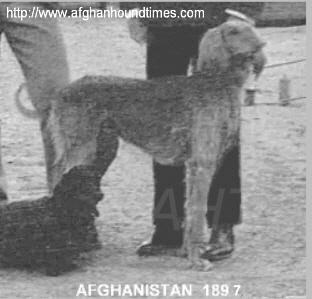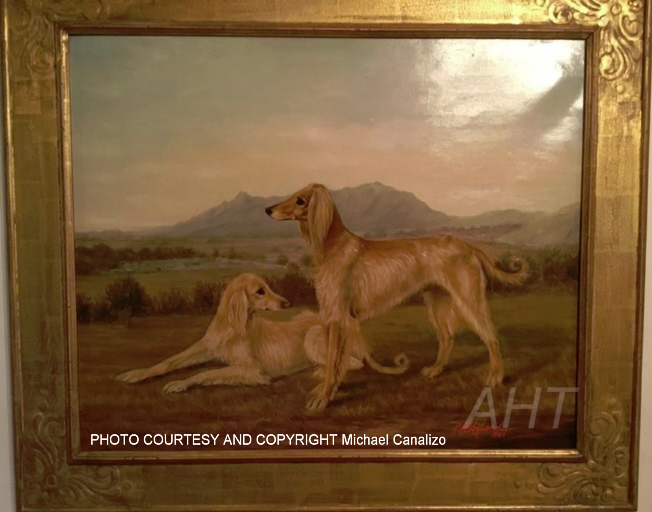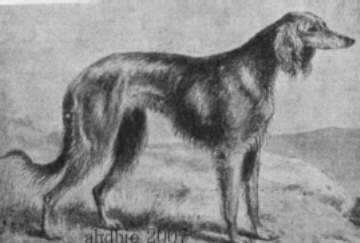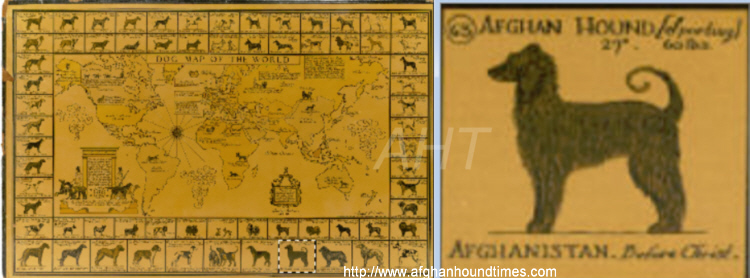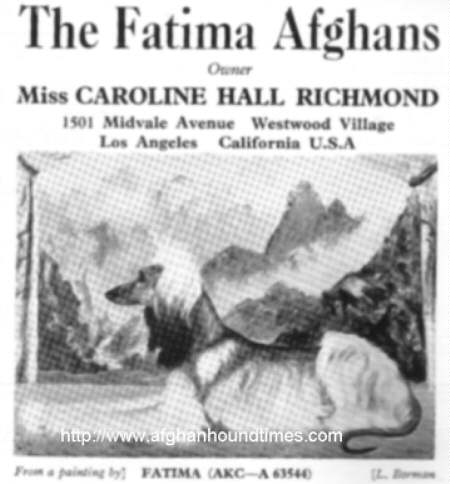(Afghan Hound Database and Breed Information Exchange)
ESTABLISHMENT OF THE BREED WORLDWIDE (By Steve Tillotson 1996, updated 2011,2014,2018) Page 1
EARLY DESCRIPTIONS/ILLUSTRATIONS/PHOTOGRAPHS ETC OF THE AFGHAN HOUND As mentioned in the origins section and in various articles on AHT, there is very little reliable information or photos/illustrations of Afghan hounds in their native country, The scant information that is available, is usually so vague, or generalised as to be meaningless. In the section on Legacy Writings readers will learn that these early writings were typically written by authors who had never been to Afghanistan or India, or even seen an Afghan hound. They relied on third parties for descriptions and illustrations of Oriental or Eastern Hounds. The earliest "reliable" author writing about our breed - Clifford L Hubbard got the closest to finding an illustration resembling an early Afghan hound. The illustration was published in his book (The Afghan Hound Handbook, 1951) and is entitled - " The Meenah of Jajuh" (a native archer) with what appears to be a "small" Afghan hound beside the native. The illustration was originally published in a publication in India in 1813. Hubbard details this find on page 9 of his book. After further study of the illustration, Hubbard comments that the hound "is not so small as first imagined". The earliest photos we have of what we would recognize as Afghan hounds today is probably that of a photograph of Mustapha, in the Strand Magazine,London, 1894. The next earliest photos we have are of Shahzada, born c 1891 and his Museum mate Moroo. The bodies of both were donated to the British Museum and stuffed and put on display in 1903 where they remain to this day. In January 2018 we were fortunate to find a photograph of an Afghan hound, taken in its native land in 1897, Readers can view the full 1897 article here -
We shared the photo and had a discussion within our Afghan hound Facebook community. The consensus was that this photograph does look like a typical Afghan hound at the turn of the century. Several commented about the head perhaps looking a bit like a Saluki head and we noted that a few of the early Bell Murray Afghan hounds showed a similar type of head. Below is a photo published in 1924 of an Afghan hound puppy bred by Jean Manson (Cove kennel, Bell Murray breeding). You can see a similarity in the head with this Pup and the 1897 hound.
We are reasonably confident in concluding that the 1897 photograph is the oldest photograph of an Afghan hound that we have found to date. The photo pre-dates formal classification of the breed name "Afghan Hound". The article accompanying the photo names the breed as an "Afghan Deerhound".... . Another early depiction of the Afghan hound existst via two paintings by the british artist B.A. Hyland which dates from around 1888
NATIVE ORIGINS AND THE 20th/21st CENTURIES The traceable origins of the modern westernised Afghan hound begin with the native hounds imported to the UK in the 1920's (and some additional imports later in the 30's and a few more in later decades) from Afghanistan and India, Legacy writers in the early 20th century often referred to Afghan hound type breeds as Oriental Hounds or Persian Hounds, (a name that later became synonymous with the Saluki or Gazelle hound). There are today a wide variety of names given to native hounds of the type that exist in Afghanistan, Pakistan, Uzbekistan/Russia and beyond such as - Tazi, Taigan, Kalagh etc. There is a lot of interest and enthusiasm shown by specialist social media groups for these native hounds. There are clear similarities between some of these native hounds and the westernised Afghan hound, but, the westernised Afghan hound pedigree history has been documented for over a century, whereas native breeds generally lack any formal documentation or depth of breeding history. It seems likely there is some common ancestry between westernised Afghan hounds some of these native breeds. However, many of these native hounds display unusual attributes or characteristics such as coat patterning, physical conformation and proportions, unusual coat colours and markings not found or documented in westernised Afghan hounds. This is suggestive of outcrossing of native hounds, something that does not apply to the westernised Afghan hound in the last 100 years. AHT believes there is space in this world for both purebred and native bred hounds, but that it is a nonsense to label native bred varities as Afghan hounds, in the absence of any records linking modern native hounds with the documented westernised Afghan hounds breeding history. AHT was the first dedicated Afghan hound website, dating back to the 1980's, and the first breed site to document native hounds and Kalagh hounds and description of Taigan hounds some 25 years ago. DIFFERENT TYPES AND ORIGINS OF THE UK FOUNDATION AFGHAN HOUNDS People often believe that the Afghan Hound was first imported into England, and thence to the rest of the world. Well as we see above, the first contributing hounds from Afghanistan were imported into Scotland (Bell Murray/Cove) in 1921. Several of these Bell Murray hounds later came south to English breeders who bred the Bell Murray lines.. The first contributing hounds that were imported directly to England from Afghanistan arrived several years later in 1925 when Major and Mrs Amps (Ghazni) returned to England and established their Ghazni kennel in Staffordshire, England, We should also note that the origins of the breed in the UK are not confined to these two types. In addition to Bell Murray/Cove and Ghazni hounds, other imports of the UK foundation era that impacted the breeding/pedigree history included - Shahzada, Afroz, Ardmor Anthony, Lakki Marwat. Noting the previous section above about native origins, we should note that most of the founding imports were procured from various locations in Afghanistan or India, exact geographical locations usually unknown. Many were imported with no known pedigree, or a very short pedigree. These imports involved a wide variety of types, long bodied/short bodied, tall/short, well coated/sparsely coated, refined/heavier set etc. These were largely native bred hounds purchased by the importers anywhere they were able to obtain acceptable specimens. Thus, putting some retrospective context to the previous discussion on native hounds, the modern Afghan hound breed is a product of native hound origins, but has enjoyed a century of pedigree breeding since it's arrival in the west,
DIFFERENT TYPES AND ORIGINS OF THE USA FOUNDATION AFGHAN HOUNDS (Afghan Hounds were exported to the USA from the UK before any of the famous USA /foundation kennels obtained the breed,. The first Afghan Hounds registered by the AKC were registered by the Dunwalk kennel in 1926. The three registrations were Bell Murray importations from the UK. The O' Valley Farm kennel registered the first homebred litter with the AKC in September 1928. Another early enthusiast was Mr E Abram of "De Flandre" Afghan Hounds .While these kennels do not contribute to the breeds pedigree history, they earned the distinction of being the earliest pioneers of the breed in the USA). Similar to the UK, the USA foundations were also enhancd by Asian imports - Lawrence Peters pair of Afghanistan imports - Tazi Of Beg Tute and Saki Of Paghman are very significant in the history of the breed in the USA. Other early USA Asian imports included Fatima (Caroline Hall Richmond's Fatima kenels), Umberto (Venita Vardon Oakie's Oakvardon kennels).
Of the foundation import lines that contribute to USA pedigree history, the first imports arrived on the West Coast in California - Miss Caroline Hall Richmond's (Fatima Afghan Hounds. Miss Hall imported two Afghan hounds from India in 1929 . The most well known hound of Miss Caroline Hall Richmond's kennel was the import from India "Fatima" (Original name Jamshepur Fatima) who arrived with her sister Jamshepur Souriya, Fatima would go on to produce offspring for Miss Richmond, the first litter whelped in January 1936., We have no further information about Souriya after her brief show period in 1929. The next of the foundation import lines were purchased in England by Zeppo Marx, of Marx Brothers fame. The Marx brothers were doing Vaudaville in London and Zeppo contacted Phyllis Robson (Owner/Editor of "Dog World" canine newspaper), who helped him select and purchase Westmill Omar and Asra Of Ghazni in the Spring of 1931. Zeppo eventually transferred them to George Thomas (Barberryhill Kennel) sometime after October 1931. George Thomas then sold them to Q A Shaw Mckean (Prides Hill) in early 1932 .(Asra was already in whelp to Omar at this stage and just a few weeks away from giving birth to a litter of five which whelped in April of 1932). The USA breeds pedigree history effectively starts with the Prides Hill imports mentioned above and this kennel was by far the most influential of the USA foundation eras. Allthough Miss Hall's imports arrived a couple of years before Prides Hill's. Miss Hall didn't breed a litter until 1936. Q A Shaw Mckea's first litter, as mentioned above, whelped earlier in 1932. Q A Shaw Mckean also imported another English dog - Badshah Of Ainsdart who came over with his litter Brother - Tufan Of Ainsdart (who went as a foundation stud to the Kandahar kennel of the White sisters in Santa Fe, New Mexico). Miss Hall's one and only litter from Fatima was sired by Tufan of Ainsdart. Laurence Peters bred from his Afghanistan imported breeding pair (Tazi of Beg Tute and Saki of Paghman) in March 1935 Another Asian import was the dog "Umberto", imported from India by Venita Vardon Oakie (Oakvardon kennel) , he arrived in the port of Los Angeles on 10th October 1937. The Oakies also imported an English dog - Westmill Natanz in 1940.
The above is a photo of a painting of Fatima done by L Borman and was published in the dog press in 1939 with accompanying narrative from Phyllis Robsom the editor of UK Dog World. - "The glorious Fatima was born in Afghanistan in 1928 and is her owners friend, pride and joy. (AHT note. Fatima was registered in in the AKC stud book in May 1936. The AKC registration states Fatima was imported from India) She is a red-gold with a black mask and has the muchly desired Eastern outlook. She is a wonderful breeder, though it was not until she was 8 years of age that she had her first litter, comprising 5 males and 3 females and 4 have become champions. Miss Richmond has retained 1 son and 3 daughters which are extra good. The dog is a big smoky brindle, with a black mask. He wa best of winners as a 10 months puppy at a 5 pt. show. He is 29 inches at shoulder, weights 70 lb, yet has not a trace of coarseness, and is the most typical outstanding hound in the States to-day. Another lovely bitch is Queen of Sheba who has 6 puppies by Tufan. There is also Blue Mist of Egypt a blue chinchilla, and Fatima's Daughter Peri a chinchilla, blue and quite famous, as well as Fatima's Daughter Kushdil and Fatima's Daughter Fatima. Queen of Sheba, Blue Mist and Nadir Khan came from Afghanistan so they are a complete outcross to exportations from England". (AHT note. Blue Mist and Nadir Khan did NOT come from Afghanistan, they were USA bred our of (Tazi Of Beg Tute x Saki Of Paghman). Effectively Blue Mist and Nadir Khan are of Afghanistan lineage, but we think it important to clarify Miss Robson's statement so that readers do not misunderstand and think that these offspring were imports).. 5.In 1934 Q A Shaw Mckean imported Badshah of Ainsdart, and his litter brother Tufan Of Ainsdart, the latter being transferred to Ameilia White (Kandahar) in New Mexico. Fatima was mated to Tufan and produced several champions from this breeding. 6. So, its probably more accurate to state that Q A Shaw Mckean was the driving force in establishing the breed on the East Coast as well as providing founding stock for other pioneering kennels across the country. For example - Kandahar (New Mexico), their foundation stock included Zara Of Prides Hill and Ch Amanullah of Kandahar both bred by Q A Shaw Mckean at Prides Hill. Miss Caroline Hall Richmond also contributed to establishing the breed on the Western side of the country. (India) We tend to talk about "Afghanistan" as the country of origin of our hounds, but we don't really know enough about India and its role and contribution. At the turn of the 20th century, the "gateway" to Afghanistan was via the military presence in India and their excursions into Afghanistan. Imports from Afghanistan invaribly came via India as this was the main shipping route of that era. The photograph we show below of the Zardin family type was taken in INDIA -
So there is some doubt/confusion about the country of origin as opposed to the country of shipping with some of the early imports. Further, we know that Major and Mary Amps (Ghazni) maintained kennels in Afghanistan and India, some of the Ghazni's being bred by Native servants. Also, some hounds were exhibited in India before being exported to the UK, for example Zardin and Sirdar were both exhibited in India before being exported to the UK. We hope to establish a research contact in India and see if we can clarify and make a clearer statement at some future point. (Signfigance Of Some Early/Non Contributing Afghan Hounds) The Afghan Hound was accepted as an established breed in 1926 when The Kennel Club (UK) granted the breed individual breed classification and awarded the breed its first CC's (Challenge Certificates). Click here to read the KC statement from 1926 Prior to 1926, Afghan Hounds were usually entered in "Variety" or "Foreign" exhibit classes. Whilst there were quite a number of early Afghan Hounds exhibited in England prior to 1926, most of them (one notable exception being - Zardin) had no impact on the breed. However, whilst these early Afghan Hounds do not figure in the pedigrees or bloodlines today, their existance and appearances at shows did a lot to promote interest in the breed. By registering these early Hounds the owners helped encourage The Kennel Club to recognize the validity of a new breed and by virtue of increasing registrations, breeding and show appearances, encouraged the KC into granting the breed individual classification in 1926. Other factors such as the existance of a Breed Standard (AHC, 1925) for Afghan Hounds further encouraged The Kennel Club. So, these early Afghan Hounds, their owners, their exhibitors and other pioneering people in the breed did a lot between the 1880's-1926 to help establish The Afghan Hound.. (Renaming Of Dogs In The Early Days Is A Problem For Researchers) In the early days of The Kennel Club it was permissable to totally rename a dog. For example, in my "tail chasing" (pedigree hunting) days I was stumped and could not find Manda Of Chaman (UK). A few years later I eventually located the "Transfer Of Ownership" record. Manda Of Chaman had been renamed "Keschang Of Pushtikuh". just prior to transfer to new owner. The Chaman affix belonged to Molly Sharpe (UK), the Pushtikuh affix belonged to Mrs Semple (UK). To further complicate my hunting down Manda - she was exported to Canada and then re-exported later to the USA. This was as late as the mid 1930's. One also has to be aware that one dog may appear at a show under various names (see Muckmul, Mustapha, Shah below). (What Should We Call An "Afghan Hound"? What about "Persian Greyhound"?) In those early days (1880-1910) it was quite common for an (Afghan Hound) to be entered in the "Foreign Dog" or "Variety" classes, often without the breed being stated, or the name of the breed stated varied between (for example) Persian Greyhound, Afghan Greyhound, Afghan Sheepdog, Barukhzy Hound and many other exotic names. You will see evidence of this as you explore the timeline below. You will also see evidence that despite achieving KC recognition and a separate breed classification that Afghan Hounds continued to be entered in Foreign/Variety classes sometimes, and "Persian Greyhounds" were also still being exhibited. (If the term Persian Greyhound means Afghan Hound why were the PG's not entered as Afghan Hounds? Jess Ruffner-Booth kindly provides us with a plausable explanation on the use of the term "Persian Greyhound" - "Hounds were variously called Barukhzy hounds, Cabul (or Kabul) hounds, Baluchi hounds, Balkh Greyhounds, Afghan greyhounds, and Tazis. They were also referred to as Persian greyhounds, and this is where things get confusing. (The British called pretty much any sighthound-shaped dog a greyhound.) Accounts, usually by military personnel who were actually in the country of origin and saw the dogs in question, frequently refer to Afghans as a type of Persian greyhound. A distinction is made between the 'regular' Persian greyhound, which had silky hair, short on the body and long on the tail and sometimes the ears and backs of the legs, and the 'hairier' form, also found in India, which had hair on the body as well, typically the thighs and shoulders. Sometimes it is stated that both types are found in the same location. Sometimes the hairier dogs are relegated to the mountains. Later accounts shift the name to Afghan greyhound, which is often elaborated on as a variety of Persian greyhound. Once this information got back to England, where authors were often relying on second or third-hand information, very often from another author that was also relying on information from elsewhere and had never seen an example of the dogs in question, everything gets a bit mixed up. The Persian greyhound type then gets divided into several sub-breeds, including Turkish, Afghan, etc".
Some examples and notes about early Afghan Hounds, (and some Non-Afghan Hounds) that do not contribute to the pedigree/breeding history but may have contributed to promoting the breed and helping it become established (Early show entries, Crufts, WKC and others) Below are some pages from early Crufts show catalogues detailing some of the early Afghan Hounds, many of which did contribute to the pedigree/history of the breed Related content: Ghazni UK Afghan Hounds Section The Hyland Painting The Origins Section Races de Chiens by Compte Henri Bylandt 1897 edition (Shahzada and Mooroo) (Constance Miller c. 1970/And From Dennis Mccarthy book) The Afghan Hound Is An Ancient Breed. Evelyn Denyer (KAF) 1925 The Barukhzy (Afghan) And Allied Eastern Hounds. (Extract) by W. D. Drury 1903 Robert Leighton on Mrs Amps Ghazni 1926 UK - KAF (Bell Murray) Afghan Hounds, A Croxton Smith, Country Life 1926 (extract) Extract on The Afghan Hound from "The Practical Dog Book by Edward C Ash m.r.a.c (Dip. Hons.) 1931 The Barukhzy (Afghan) And Allied Eastern Hounds (Extract) from "British Dogs, Their Points, Selection, And Show Preparation", by W. D. Drury 1903 Afghan Hounds In India, Steve Tillotson, 2012 |
